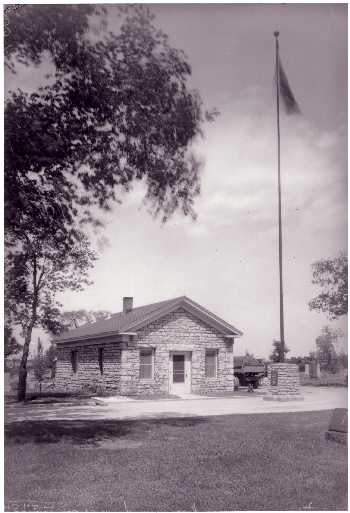 |
Minneapolis Pioneers and Soldiers Memorial Cemetery History Page Alley Article |
| Home | Burial Search | Friends | History | Photo Gallery | Visitor Information |
| Alley Articles |
|
This article originally appeared in the Phillips community's Alley Newspaper, March 2006. In the heart of the redevelopment that’s going on along Lake Street and in the Phillips community, Minneapolis Pioneers and Soldiers Memorial Cemetery is one of the few places that remains largely unchanged. Since it was first established in 1854, some new structures have been added. That is, they’re new, if you consider something that’s 155 years old to be new. The caretaker’s cottage is almost certainly one of the oldest existing buildings in South Minneapolis. It was constructed in 1871, approximately the same time that the cemetery’s original owners, the Layman family, added an additional ten acres of their farm land to the ten acres already in use for burials. Architects call the building’s style Greek Revival, a name that suggests a more formal feeling than this modest building conveys. And it is a beautiful building, a one-story structure made of rough-cut limestone blocks. The wooden trim around the doors, windows and eaves of the building are freshly painted, a dark green to match the building’s asphalt shingles. The interior of the building has gone largely untouched since the late 1920’s. The building is divided into three sections. There is an office which contains furniture that might generously be described as “vintage.” The office is heated by an old space heater, and the building does not have air conditioning. The floor is painted concrete, and the walls are painted the shade of mint green commonly used in public buildings in the middle years of what is now the last century. The two other rooms serve as work spaces although there is evidence that the kinds of use that they receive has changed over the years. In the middle room, there is an old safe and an upright piano. It’s been a long time since money changed hands or songs were sung in that space. The back room once served as the cemetery’s vault, used to store the remains of people who died during the winter but who couldn’t be buried until after the spring thaw. The original cast-iron stove used to heat the vault is still there, though it probably hasn’t been used in 100 years. The style of rakes, shovels and hoes, tools of the caretaker’s trade, hasn’t changed much since the cemetery opened, although the originals have certainly worn out and been replaced. The cemetery was placed on the National Register of Historic Sites in 2002, and the caretaker’s cottage was one of the “contributing structures” that helped make that possible. The cemetery has been nominated for the City of Minneapolis’ historic designation, and a vote on that will be taken in the next month or two. The cemetery is closed until April 15th, but when it reopens, be sure and stop by and take a look at one of the city’s oldest, and most beautiful, architectural treasures.
Next Article -> Public Hearing -- May 2006 |
|
©Friends of the Cemetery, 2005-2008 Contact us at history@friendsofthecemetery.org |
File last updated: Tuesday October 17, 2006 |
